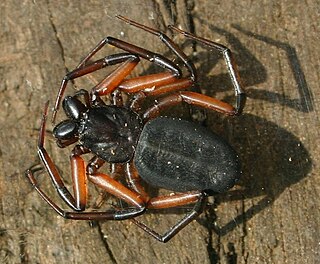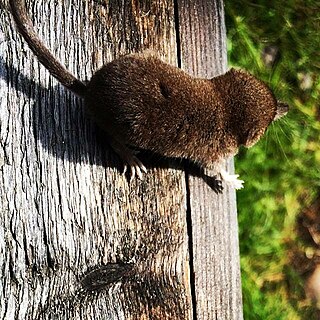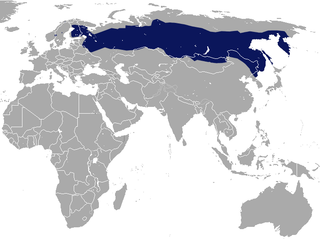
The Yellow Sea is located between China and Korea. The name is given to the northern part of the East China Sea, which is a marginal sea of the Pacific Ocean. It is located between mainland China and the Korean Peninsula. Its name comes from the sand particles from Gobi Desert sand storms that turn the surface of the water golden yellow.

Hornbeams are hardwood trees in the flowering plant genus Carpinus in the birch family Betulaceae. The 30–40 species occur across much of the temperate regions of the Northern Hemisphere.

The Russian Far East comprises the Russian part of the Far East, the eastermost territory of Russia, between Lake Baikal in Eastern Siberia and the Pacific Ocean.

The Trochanteriidae are a spider family with about 150 species in 19 genera.

Laxmann's shrew, or the masked shrew, is a species of shrew. Its range extends from northern Scandinavia and the Baltic to the Sea of Japan, including Hokkaidō, Sakhalin, and the Korean Peninsula. It favours mountain forests but is sometimes found in tundra and moorland, and also in lowland areas as well. It avoids cultivated land.

The Ussuri shrew, also known as the giant shrew, is a species of shrew found in Northeast Asia. An adult Ussuri shrew has a total length including the tail of 137 to 170 mm. It is found in valleys and on the forested slopes of mountains in the Korean Peninsula, northeastern China, and the Russian Far East. It is rarely observed, and its ecology is largely unknown.

The Siberian large-toothed shrew is a species of shrew. An adult Siberian large-toothed shrew has a weight of 4.6-6.0 grams and a body length of 5.5-6.4 centimeters, with a tail of 2.4-3.75 centimeters. This species is found across Northeast Asia, from Mongolia through northeastern China to the Russian Far East and the Paektusan region of North Korea.

The taiga shrew, also known as the even-toothed shrew can achieve a body length of about 67 millimeters, with a tail of about 43 millimeters. This shrew is very similar to the long-clawed shrew. This species inhabits forested mountain valleys, and is found across northern Eurasia. It ranges from the Baltic Sea area through the Lake Baikal region of Siberia into the Russian Far East and along the Baekdudaegan mountains of the Korean Peninsula.
Anomalepis aspinosus is a species of snake in the Anomalepididae family. It is endemic to Peru. The skull and some of its permanently cartilagenous elements, as, for instance, the concha and other parts of the nasal capsule and the trabecule cranii have been studied. The trigeminal musculature and the depressor mandibulae has been observed. The head musculature proved to be different in many several points from Liotyphlops, the other partly investigated Anomalepine. Details on the exits of cranial nerves and the topography of the cranial glands has been studied in order to get a better understanding about the position and origin of the Typhlopoid snakes, which form a quite separate and not too small systematic unit strongly different from other groups of snakes. In order to get an idea of a primitive Typhopoid snake, information about the "aberrant" genera had to be combined with the already known features of the best-known genus, Typhlops; therefore, both Anomalepines had to be studied and compared with Typhlops. It is clear and evident that the Anomalepines are in many cranial characters more primitive than Typhlops, as by the presence of the remnant of the ancestral jugal arch(composed of the postorbital exclusively); by the presence of a big ectopterygoid and a prefrontal not fused with a rigid burrowing snout as in Typhlops. On the other hand, the fusion of the pair of nasals and the formation of a septum nasi osseum as a result of this fusion are features unknown in Typhlops. In Anomalepis, no tabular is found as in Liotyphlops. Typhlops, however, is more primitive in retaining a splenial in a peculiar position sharing with the dentary the symphysis. The peculiar retractor maxillae muscle of Typhlops is replaced by a double-bellied enlarged m. pterygoideus.
Eugene Nicolas Kozloff was an American marine biologist and botanist at Shannon Point Marine Center on Fidalgo Island, Washington. He was an emeritus professor of the Friday Harbor Laboratories, University of Washington, and is best known for writing field guides for the Pacific Northwest Region of the United States.
Cyclorhagida is an order of kinorhynchs, which are small marine invertebrates.
Echinoderes obtuspinosus is a species of mud dragons first found in coastal and subtidal locations around the Korean Peninsula and in the East China Sea.
Echinoderes microaperturus is a species of mud dragons first found in coastal and subtidal locations around the Korean Peninsula and in the East China Sea.
Echinoderes cernunnos is a species of mud dragons first found in coastal and subtidal locations around the Korean Peninsula and in the East China Sea.

Anoplodesmus is a genus of millipedes. It is one of the most species rich genera in the family Paradoxosomatidae, with over 40 described species distributed from India and Nepal to China and Southeast Asia, as well as the Mascarene Islands and Fiji.
Stellantchasmus is a genus of trematodes in the family Heterophyidae.
Cephalorhyncha is a genus of kinorhynchs in the family Echinoderidae.
Echinoderes is a genus of mud dragons first described in 1863. It is the largest genus within class Kinorhyncha. It is a highly diverse genus, with member species that inhabit "most marine benthic substrates, on latitudes ranging from the Arctic to the tropics, and from the intertidal zone down to the deep sea." Species on the east coasts of North and South America have been extensively studied by Robert P. Higgins. Species in east Asia have been extensively studied by A. V. Adrianov.











